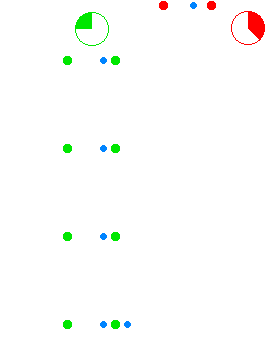
The 2018 part 1 Electricity Notes.
this is the pdf version of the document above covering a.c/ d.c, rms, resistance, circuits, and emf.
And even hotter off the press part 2 Electricity Notes, sorry these have taken 6 months!

Remember

An LED is FORWARD biased. A photon is emitted when an electron falls from the conduction band into the valence band.
Power Matching (word) Power Matching (pdf) Here is a task to show how to get the greatest power from your circuit. I’ve uploaded it as a pdf and word document.
Here are the answers in an excel spreadsheet, but don’t peek until you’ve completed your own graphs and table! power matching
White Board Revision of Electricity 2
final-question-past-paper Here are the questions from the Revised Higher Physics Papers in topic order with the marking instructions. If you can’t read this I can upload as a pdf file, just ask!

A graph of current against time for charging and discharging at different frequencies. Notice how at low frequencies (0-16s) the current can drop quite low, whereas at higher frequencies (16-26s) their is greater current overall.
Here is a nice introduction to semiconductors
Band Theory
My powerpoint for this section contains some exciting explanations that I’ve “borrow” from Chris Hooley, Paul at High School Physics Explained and helpmyphysics. The first powerpoint is 588MB so I’ve had to break it up to upload it. If you want to use it you’ll need to download each part and paste it all back together!


I’ve taken out the embedded videos so some of the helpmyphysics, you might need to cut some of it. Hope it helps you.
[table id=16 /]2016 Higher Question Paper
Some cars use LEDs in place of filament lamps. An LED is made from semiconductor material that has been doped with impurities to create a p-n junction. The diagram represents the band structure of an LED.
A voltage is applied across an LED so that it is forward biased and emits light.
Using band theory, explain how the LED emits light.

(Voltage applied causes) electrons to move towards conduction band of p-type/ away from n-type (towards the junction) (1)
Electrons move/ drop from conduction band to valence band (1)
Photon emitted (when electron drops) (1)
Anderson High School
Thanks to N. Hunter for these great notes from Anderson High.
This is the end of the course! Thanks for making the journey with me. Just revision to do now. All of those resources can be found in the REVISION section.
Worked Answers
For speed I will add some of the worked answer files here until I can produce an answer booklet, which I’ll do a.s.a.p.
electric fields and resistors tutorials 2010
ac voltage tutorials answers corrected
electric fields and resistors tutorial answers
















